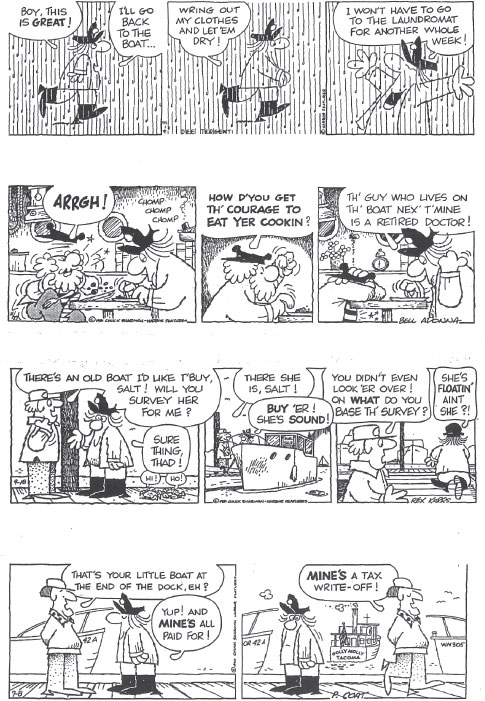NO CONTEST: If a $5.00 bill is placed on a table, it can easily be read by passersby. But if $5.00 in assorted change is tossed on the table it could turn out to be a contest to see who could guess the proper amount. In drawing a gesture it should be recognized immediately and not turn out to be a contest.
CREATIVE ENERGY: There is a vital creative energy that builds up in an artist as he proceeds to draw. As he is caught up in the thrill of the project, his thinking is accelerated by each successful line he makes. It arouses all his faculties so that there is input from the farthermost parts of his consciousness. Many of the observations he has made in the past come to the fore. He soon discovers himself beyond that line which convention has constrained him to stay behind. He is suddenly armed with all those sleeping genies that have been lying in wait for these special moments of intensification — these moments when the desire to perform wins over the mere half-hearted attempts to make a drawing.
GO WHOLE HOG ON ACTION AND POSES: Your action and gestures should be as broad as your audience is going to be. If you were a painter you might have patrons who like things painted a certain way, so you can direct all your expression to and for them. In cartooning your audience is not so narrow in their tastes (and perhaps discernment), so your expression has to be broad enough to gratify them all. Many of them need it all “spelled out,” real clear like. Laughter is usually what you are after and if you deliver humor in a hesitant way, your audience will be hesitant to laugh at it.
STRETCH YOUR TALENTS: Keep reading and observing to increase your range of understanding. By so doing, you will be better able to adjust to the variety of stories and characters; and better able to work with the various directors and their particular approaches to story interpretation.
Having your talents guided and influenced by the directors and/or the story people, doesn’t mean giving up your individuality — it does mean using your creative ability in a broader sense. So the broader your “world view,” the more all-encompassing will be your contribution.
BREAK THE CHAINS OF CONFORMITY: Most of my criticism in the evening drawing classes has to do with the artists straightening things up. We are raised in a society where things must be orderly: “straighten up your room,” “trim the hedge,” “straighten your tie,” “stay in your lane,” and “walk the straight and narrow.” It takes a conscious effort to break away from this kind of inflicted thinking, which, in an artist’s life, becomes a straitjacket for the imagination.
ADD TENSION TO YOUR DRAWINGS: In our daily lives we avoid tension. Tension, of sorts, enervates us and saps our enthusiasm. Actually, tension is an indication that life exists. Just to stand up creates physical tension in the body. And when people want to put a little spice in their gestures they add more tension, stress, or torque. Symmetry in architecture may give you a feeling of stability, but in drawing and in humor, symmetry becomes lifeless. Tension, in a sense, forces the gesture out of the body by means of opposing force, altered balance, or augmented energy through the use of angles, squash and stretch, and greater emphasis on the action.
KEEP YOUR THOUGHTS STIRRED UP: When I recommend reading, attending good movies, and observing life around you (preferably with a sketch book in hand), I don’t mean just doing it as a means of passing time. It’s a way of keeping that constant stream of thoughts — that inner dialog we all engage in — stirred up and cross-indexed.
A good writer will use what I always advocate in drawing — verbs. A friend of John Muir’s, a missionary named S. Hale Young, had a way of making the landscape come alive in his writing. After accompanying Muir on a trip into Alaska, he described the icebergs as, “Charging down upon us like an army, spreading out in loose formation, and then gathering into a barrier.” I underlined the verbs to emphasize how he made a lot of frozen ice seem alive, active, and in a sense, gesturing.
The writer whose article I got this from is just as colorful. He says of their trip:
Yosemite-like canyons still in the making yawned on either side. Awesome rivers of ice ended in avalanches. Whale-size ice chunks plunged seaward, breeding huge waves and swells, and endless fleets of icebergs streamed out to sea. The slowly receding glaciers left in their wake a land totally wild and newborn, scraped clean of vegetation.
That kind of descriptiveness should be present in your drawings. Not just a lot of frozen lines that form an outline of something, but active, living lines that describe your character as doing things, and doing them in a descriptive way.
Comedians arouse a different kind of picture in your mind. They use a sort of twist that shocks you out of your normal state or realism. Like Groucho Marx saying “I would horsewhip you if I had a horse.” Or like the other day someone made a remark about another person of questionable intelligence, saying, “He acts like he doesn’t have both oars in the water.”
Humor isn’t always wisecracks, buffoonery, and silly drawings. Good humor often contains some real good common sense like these strips of Salt Chuck on the Rocks! by Chuck Sharman.

